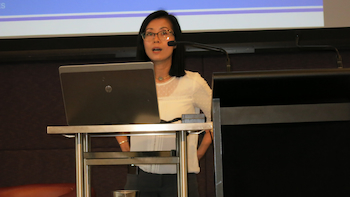Revised AML, DLBCL and HL Optimal Care Pathways released
Newly revised optimal care pathways (OCPs) provide best practice information for the treatment and care of people living with acute myeloid leukaemia (AML), and diffuse large B-cell lymphoma (DLBCL) and Hodgkin lymphoma (HL).

And new OCPs are being developed for an additional six blood cancers. These are: chronic lymphocytic leukaemia; myeloma; low grade lymphomas (follicular lymphoma, marginal zone lymphoma, mantle cell lymphoma); chronic myeloid leukaemia; myelodysplastic syndromes; and childhood, adolescent and young adult acute leukaemias.
The pathways describe the standard of care that should be available to every blood cancer patient treated in Australia. They support patients and carers, health systems, health professionals, and services to encourage consistent optimal treatment and supportive care at every stage of a patient’s journey.
The new blood cancer OCP project is being jointly led by the Leukaemia Foundation, the Australasian Leukaemia & Lymphoma Group (ALLG) and the Haematology Society of Australia and New Zealand (HSANZ), following a commitment by the Federal Health Minister, Greg Hunt as part of the launch of Australia’s first National Strategic Action Plan for Blood Cancer (National Action Plan), in September 2020.
The Blood Cancer Taskforce is overseeing implementation of the National Action Plan, and one of the priorities is to reduce disparities in survival outcomes and promote best practice standard of care for all people diagnosed with a blood cancer regardless of where they live or their background.
The OCP project is an important first step towards achieving that goal. Among the 15 existing OCPs, those for AML, DLBCL and HL have been updated by the Cancer Council of Victoria and these second editions have been published. The six new blood cancer OCPs will be published in 2022.

The ALLG is responsible for Chairing the OCP Steering Committee and coordinating the development of the clinical content, and the Leukaemia Foundation is responsible for overarching administration of the project as the secretariat and for coordinating the development of the OCP consumer guides.
In his introduction to each OCP, Professor Robert Thomas, Chair of the Optimal Care Pathways Project Steering Committee says the OCPs should be read and understood by all health professionals involved in cancer care – haematologists, oncologists, radiologists, surgeons, general practitioners, allied health professionals, nurses and cancer service managers, and trainees.
In the AML OCP, the timeline recommendations include morphological assessment to identify acute promyelocytic leukaemia being carried out straight away and the physician being advised of the result as soon as possible. For all patients with AML, it recommends that results that affect immediate management decisions should be available within 72 hours of the patient presenting.

The AML OCP also recommends that induction treatment begins promptly after diagnosis and confirmation of a treatment plan, and that the consolidation therapy begins within six weeks of the start of induction chemotherapy. Also, once a patient’s risk status is known, the search begins for a bone marrow donor.
What are optimal care pathways and why do we need them?
All patients should receive timely and high-quality cancer care. While Australia has one of the best healthcare systems in the world and cancer survival rates among the best in the world, there are disparities in cancer treatment and inequalities in patient experience and cancer survival.
The pathway for cancer patients undergoing diagnosis and treatment is complex and involves multiple healthcare providers and a range of institutions, both public and private. Understanding and navigating this while burdened with the physical and emotional weight of cancer adds to this complexity.

Optimal Care Pathway resources have been developed to provide a national standard of high-quality cancer care that all Australians should expect and to foster greater collaboration between health professionals and people affected by cancer. An OCP provides a template against which variations in care can be assessed and understood.
Three interrelated documents make up each OCP – the full Optimal Care Pathway, a Quick Reference Guide, and a consumer guide.
Who are the OCPs for?
The OCPs are for health professionals, patients, carers, and anyone affected by cancer or involved in cancer care. OCPs should be read and understood by all health professionals involved in cancer care – haematologists, oncologists, radiologists, surgeons, general practitioners, allied health professionals, nurses and cancer service managers, and trainees.
How are the OCPs different to clinical practice guidelines?
OCPs are developed by cancer type and give an overview of the principles of high-quality cancer care at key steps in the patient experience. These include cancer prevention and early detection, initial investigations, recommended screening and tests, referral, diagnosis, staging and treatment planning, and supportive care.
These care pathways are not clinical practice guidelines. They are based on nationally agreed current best practice, and include references to clinical guidelines, standards, and research. In some cases, however, they are a statement of consensus regarding currently accepted approaches to optimal treatment.
The OCPs provide an overview of high-quality care and are not intended to constitute medical advice or replace clinical judgement. The pathways are government-endorsed and are intended to improve the quality of care, however, they are not prescriptive.
According to Professor Robert Thomas, “the decision about ‘what’ treatment is given is a professional responsibility and will usually be based on current evidence, clinical practice guidelines and the patients’ preferences”.
A combination of both clinical practice guidelines and OCPs are needed for a good patient experience and outcome and for cost-effective cancer care.
Read and download the second edition of the blood cancer OCPs:
Optimal care pathway for people with acute myeloid leukaemia [2nd edition]
Optimal care pathway for people with Hodgkin and diffuse large B-cell lymphomas [2nd edition]
Last updated on February 23rd, 2022
Developed by the Leukaemia Foundation in consultation with people living with a blood cancer, Leukaemia Foundation support staff, haematology nursing staff and/or Australian clinical haematologists. This content is provided for information purposes only and we urge you to always seek advice from a registered health care professional for diagnosis, treatment and answers to your medical questions, including the suitability of a particular therapy, service, product or treatment in your circumstances. The Leukaemia Foundation shall not bear any liability for any person relying on the materials contained on this website.